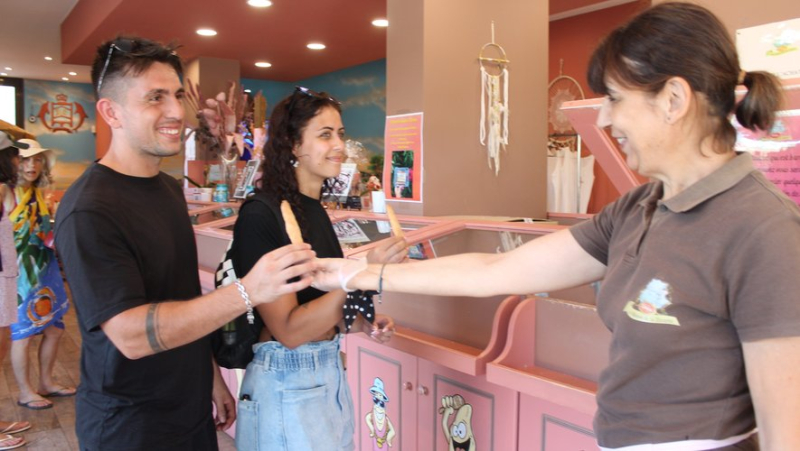La zézette, gourmet ambassador of Sète in France and around the world

Comme ces Palois, les touristes affluent de la France entière, et même au-delà, à La Maison de la Zézette. MIDI LIBRE – KELMAN MARTI
Durant l’été, les ventes de spécialités locales, comme la zézette, augmentent grâce aux vacanciers.
Brittany has its Kouign-Amanns, Montélimar its nougat, Toulouse its sausage… and Sète has its famous tielle, its macaronade, but also its funny zézettes. A long biscuit, sweet as you want, crunchy and melting in the mouth, which has become established year after year as a local specialty. For some tourists, it is even one of the must-sees in Sète, like visiting the city center, going to the beach or the Saint-Clair panoramic viewpoint.
A specialty that we discover in Sète…
"As vacationers, we seek to discover local specialties. We already knew about tielles, but zézettes are a great discovery. We ate them for the first time a few minutes ago at the restaurant", say Isabelle and Stéphane, customers from Poitiers, a tray of biscuits in hand in the aisles of a supermarket in the city center of Sète. A few meters further, Sylvie, an employee of the store, sees, "a good number of tourists passing through the checkout every day" with their zézettes.
“We have a lot of people asking for local recipes, so it sells very well. They come for Demain Nous Appartient and leave with zézettes”, Sylvie half-ironically says. An observation shared by Charlène Bentata, daughter of Gaston – the creator of the biscuit – and manager of La Maison de la Zézette located in Les Salins: “It's true that zézettes sell better in the summer with tourists. We produce between 25 and 30% more. We have French visitors, as well as foreigners (American, English, German, etc.). Often, families come and discover the zézette, then come back each year to stock up when they are passing through."
This is the case of Pascale, André and their two children: “We discovered this biscuit a few years ago and now we're going on holiday to the South-East, so we stopped in Sète for the trip's zézette break. We'll take some for ourselves, but also for friends.”
… which is shared beyond the singular island…
Because zézette is shared and for several reasons. “Unlike a tielle or a macaronade, it keeps for a long time and exports well“, confides Gaston Bentata. “It's a biscuit that pleases the greatest number, young and old, so the gift almost never disappoints”, notes Charlène Bentata.
And above all, there are the boxes. "Customers buy as much for the taste as for the boxes. There are some with old representations of Sète, and more modern ones made by the designer Dadou. These are beautiful objects that we like to offer, continues the co-manager of the brand which recently opened a store in Montpellier, Grand Rue Jean-Moulin.
… and growing notoriety
By exporting and being offered elsewhere, the zézette then becomes an ambassador for Sète. For those unaware of the existence of the city (especially abroad), the long sweet shortbread allows them to know it and this also helps to anchor "the lisp like a local specialty", in the words of Gaston Bentata.
"I would not have imagined such success, such notoriety, on a national and somewhat international level. Now, people come to Sète and already know the zézette. It's a source of pride to make my city known thanks to the biscuit, concludes, moved, its creator.
I subscribe to read more




